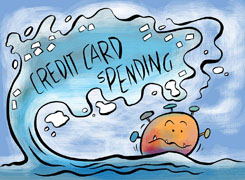Samraat Jadhav |2498 Answers |Ask -Follow
Stock Market Expert - Answered on Jun 11, 2025
He is a SEBI-registered investment and research analyst and has over 18 years of experience in managing high-end portfolios.
A management graduate from XLRI-Jamshedpur, Jadhav specialises in portfolio management, investment banking, financial planning, derivatives, equities and capital markets.... more

Hi, I am 33 yr old working in a private ltd company having a package of 13LPA. I have seen a very tough childhood with lot of financial pressure. Never indulged in any kind of luxury or hobbies. After getting job, tried to fulfill some dreams of my parents. Made some tours, bought an apartment and married my loved one. After that, suddenly both my parents got major medical issue. Heart attack and Cancer. I have made them cure completely and both of them now ok. After all that I had a debt of 40L in 2023 and I was puzzled, how to repay them. Then the worst thing happened, with social media influence I took some more loan and traded in F&O and lost another 15L. Now my total debt is 60L - 20L HL, 20L PL. 5L GL and 15L CC outstanding. I am the single bread earner for 5 persons. I am helpless. Please help me. I am a really dedicated employee and very hard working.
Phase 1: Stabilize and Stop the Bleeding
- Stop any further trading or taking on new loans — this may already be clear to you now, but your awareness and admission show that you’ve learned from it.
- Prioritize debts by urgency and interest rates:
- Credit card (15L) – likely highest interest, needs urgent attention.
- Gold loan (5L) – usually short-term, with moderate rates. Negotiate rollover if needed.
- Personal loan (20L) – medium-term priority.
- Home loan (20L) – lowest priority; keep EMIs running if possible.
- Talk to lenders now. Many offer restructuring under RBI guidelines:
- Convert CC or PL into longer-term loans with lower EMIs.
- Ask about moratorium or partial payments.
- Use the term "financial hardship due to medical emergency"—many lenders will respond better when it’s health-related.
Phase 2: Budget Like a Warrior
You earn ?13L per year (~?80K/month in hand post-tax & PF). The goal is to reduce EMIs to ~?40-45K/month if possible, leaving you enough to survive and breathe.
- Draft a no-frills survival budget—cut down discretionary expenses to zero for 12 months.
- Consider staying with extended family (if possible) to reduce rent or utility pressure.
- Free apps like Walnut or Cube Wealth can help you track and trim with precision.
Phase 3: Explore Boosters
- Secondary Income: With your skill set and dedication, explore freelance remote projects. Just 5–10K/month can be a massive psychological win and financial relief.
- Government Schemes: If your parents are now senior citizens, explore Ayushman Bharat or state-level health subsidies to avoid future shocks.
And finally—your mindset
This situation is brutal, yes. But temporary. You’ve survived the worst—health emergencies, emotional betrayal by social media influencers, and financial collapse. You’ve already paid the cost of those mistakes. You don’t owe them another ounce of your peace or self-worth.
You’re not the guy who failed with F&O trades.
You’re the guy who fought cancer and heart attacks and won.
You may like to see similar questions and answers below
Ramalingam Kalirajan |10870 Answers |Ask -Follow
Mutual Funds, Financial Planning Expert - Answered on Aug 22, 2024
Ramalingam Kalirajan |10870 Answers |Ask -Follow
Mutual Funds, Financial Planning Expert - Answered on Jul 06, 2024
Ramalingam Kalirajan |10870 Answers |Ask -Follow
Mutual Funds, Financial Planning Expert - Answered on Feb 05, 2025
Ramalingam Kalirajan |10870 Answers |Ask -Follow
Mutual Funds, Financial Planning Expert - Answered on Feb 17, 2025
Samraat Jadhav |2498 Answers |Ask -Follow
Stock Market Expert - Answered on Jun 11, 2025
Dr Dipankar Dutta |1837 Answers |Ask -Follow
Tech Careers and Skill Development Expert - Answered on Dec 05, 2025
Dr Shyam Jamalabad |108 Answers |Ask -Follow
Dentist - Answered on Dec 05, 2025
Dr Shyam Jamalabad |108 Answers |Ask -Follow
Dentist - Answered on Dec 05, 2025
Dr Shyam Jamalabad |108 Answers |Ask -Follow
Dentist - Answered on Dec 05, 2025
Dr Dipankar Dutta |1837 Answers |Ask -Follow
Tech Careers and Skill Development Expert - Answered on Dec 05, 2025
Ulhas Joshi |280 Answers |Ask -Follow
Mutual Fund Expert - Answered on Dec 05, 2025
Dr Dipankar Dutta |1837 Answers |Ask -Follow
Tech Careers and Skill Development Expert - Answered on Dec 04, 2025
Ravi Mittal |676 Answers |Ask -Follow
Dating, Relationships Expert - Answered on Dec 04, 2025
Anu Krishna |1745 Answers |Ask -Follow
Relationships Expert, Mind Coach - Answered on Dec 04, 2025
Anu Krishna |1745 Answers |Ask -Follow
Relationships Expert, Mind Coach - Answered on Dec 04, 2025




























